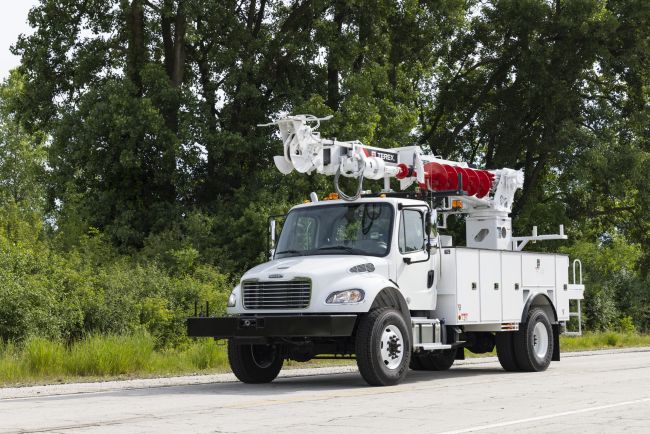
Understanding Wind Speed Limitations on Utility Equipment
Wind conditions can create hazards that must be effectively managed to ensure worker safety.
The question about what’s permitted for operating aerial devices and digger derricks in high winds is one that comes up frequently with users. Utility crews often must deal with working in wind. Trouble trucks responding during storm recovery, transmission operations to place visibility balls on lines and working above rooflines in urban locations are just a few examples. Plus, some areas of the country experience high winds regularly or seasonally.
While OSHA restricts use of material-handling aerial devices and digger derricks in winds greater than 30 mph, the reality is that both OSHA – in its General Duty Clause – and manufacturers require that operations cease in wind speeds that may be less than 30 mph if the work conditions are not safe. In addition, utilities frequently have their own policies regarding operation in adverse conditions.
The user must not assume that they can work in winds under 30 mph. The allowable wind speed that permits safe operation can change for each situation, location and work height. The people at the site are the only ones who can determine if it is safe to operate and perform the tasks assigned.
Managing the Risks
The wind conditions, the terrain, nearby buildings and objects, the work to be accomplished and the height of the work must be considered to determine if the task assigned can be safely accomplished. Among the risks that must be managed are maintaining required minimum distances between swaying objects, controlling loads being lifted and protecting ground personnel. Equipment tip-over is one of the less likely risks associated with wind, provided the equipment has been set up properly.
Both sustained wind and gusting wind can cause oscillation or sway, but gusty or erratic changes in wind speed or direction require more caution. This environmental condition causes larger oscillations in both the boom and platform to the poles and lines. If this creates a situation where the boom and power lines move toward each other, minimum distances may not be able to be maintained. This creates an unsafe condition, which is a cause to stop operations regardless of the actual wind speed. Conversely, the boom tip and the work may move apart; if the operator must stretch to reach the work, they may lose control of items they are working on, causing danger to ground personnel.
Likewise, when lifting materials from the aerial device jib or from a digger derrick, control of the load must be maintained to avoid shock-loading the boom, striking another object or dropping the load. The greater the surface area of the object, the more sail effect it creates and the greater the risk. When attempting to lift insulators or crossarms to place them, if the load cannot be held steady, risk of collision with poles or personnel must be considered.
Ground personnel, especially those holding tag lines on loads, must be protected from pinch points. A load that is not able to be controlled in the wind could create a crushing hazard between the load and truck. Falling or flying debris, which may occur during tree trimming in storm recovery, is another hazard that must be assessed. While not directly related to wind conditions, an additional resource is an OSHA Fact Sheet that expands on other hazards crews may face when conducting disaster cleanup and recovery (see www.osha.gov/sites/default/files/publications/OSHA3698.pdf).
Equipment Setup
Most aerial devices and digger derricks are not equipped with wind speed sensors. There are some pocket-sized sensors available as well as sensors that work with a smartphone to measure wind speed at ground level and at height from the platform. There are also historical wind speed records available for an area online. However, these tools should only be used as guidelines when planning operations.
In some cases, terrain or structures can act as a wind block. If possible, set up equipment in these locations, but be aware that if the boom or bucket extends above the roofline or away from the obstruction, wind speeds will be stronger once the obstruction no longer provides a wind block. In contrast, in urban areas, downdrafts and wind funnels caused by high-rise buildings can create greater wind speeds.
Another option – if the wind speed does not create other hazards – is to position the equipment in such a manner that the boom and load are parallel to the direction of the wind, not perpendicular. This will lessen the effects by reducing the area the wind will contact and lowering the amount of oscillation or sway.
About the Author: Jim Olson is a product and safety engineer for Terex Utilities (www.terex.com/utilities).

